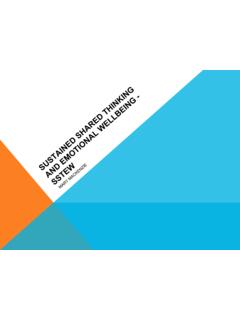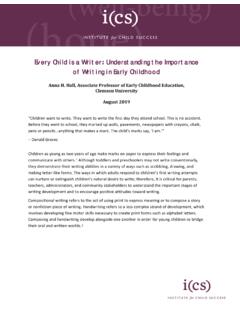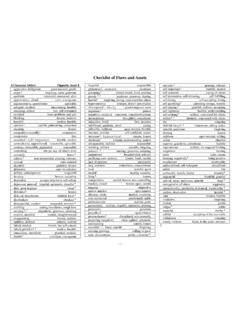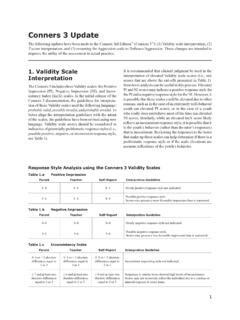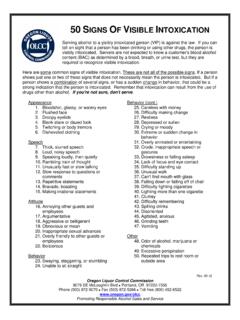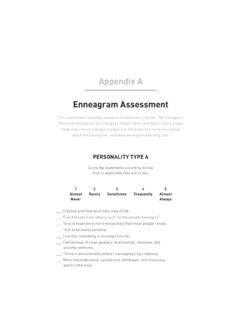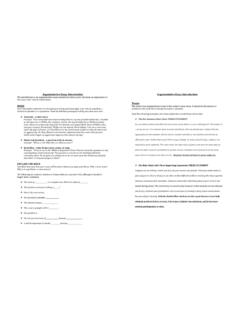Transcription of Disruptive, impulse-control, and conduct disorders
1 OBJECTIVES To familiarize yourself with Disruptive, Impulse-Control, and conduct disorders in the DSM-5 To understand the prevalence and demographics of these disorders To discuss diagnostic features, associated features, and development and course of these disorders To discuss risk and prognostic factors of each disorder To discuss differential diagnosis and comorbidities of each disorder To discuss psychopharmacology and psychotherapies for each disorderCATEGORIZING IMPULSE-CONTROL disorders THE DSM-5 WAY DSM-5 created a new chapter : Disruptive, Impulse-Control, and conduct disorders . Brought together disorders previously classified as disorders usually first diagnosed in infancy, childhood, or adolescence (ODD and CD) and impulse-control disorders NOS.
2 disorders are unified by presence of difficult, disruptive, aggressive, or antisocial behavior. Often associated with physical or verbal injury to self, others, or objects or with violation of the rights of others. Behaviors can be defensive, premeditated, or JE, LeppinkEW. Choosing a treatment for disruptive, impulse control, and conduct disorders : limited evidence, no approved drugs to guide treatment. Current Psychiatry. 2015;14(1):29-36. PREVALENCE More common in males than females Have first onset in childhood or adolescence Lifetime prevalence : ODD CD IED Any ICD Despite a high prevalence in the general population, these disorders have been relatively understudied There are no FDA-approved medications for any of these disordersKessler RC, Berglund P, DemlerO, et al.
3 Lifetime Prevalence and age-of-onset distributions of DSM-IV disorders in the National Comorbidity Survey Replication. Arch Gen Psychiatry. 2005; 62(6): BEHAVIORS The founding of juvenile court clinics in 1899 to deal with delinquents directly resulted in the creation of the child guidance movement and the establishment of child and adolescent psychiatry as a subspecialty. Disruptive Behavior disorders are the most frequent referral problems for child and adolescent psychiatrists! Account for 1/3 to 1/2 of all cases seen in mental health clinics Adult sociopathy is almost always preceded by disruptive behavior in childhoodDSM-5 disorders Oppositional Defiant Disorder (ODD) Intermittent Explosive Disorder (IED) conduct Disorder (CD)
4 Antisocial Personality Disorder Pyromania Kleptomania Other Specified Disruptive, Impulse-Control, and conduct Disorder Unspecified Disruptive, Impulse-Control, and conduct DisorderOPPOSITIONAL DEFIANT DISORDER CONFLICT WITH AUTHORITY pattern of angry or irritable mood, argumentative /defiant behavior, or vindictiveness lasting at least 6 months as evidenced by at least four symptoms from any of the following categories, and exhibited during interaction with at least one individual who is not a Mood1. Often loses temper2. Is often touch or easily annoyed3. Is often angry or resentfulArgumentative/Defiant Behavior4.
5 Often argues with authority figures, or for children and adolescents, with adults5. Often actively defies or refuses to comply with requests from authority figures or with rules6. Often deliberately annoys others7. Often blames others for his or her mistakes or misbehaviorAmerican Psychiatric Association. (2013). Diagnostic and statistical manual of mental disorders :DSM-5. Washington, : American Psychiatric DEFIANT DISORDERV indictiveness8. Has been spiteful or vindictive at least twice within the past 6 months The persistence and frequency of these behaviors should be used to distinguish a behavior that is within normal limits from a behavior that is disturbance in behavior is associated with distress in the individual or others in his or her immediate social context, or it impacts negatively on social, education, occupational, or other important areas of behaviors do not occur exclusively during the course of a psychotic, substance use, depressive, or bipolar disorder.
6 Also, the criteria are not met for disruptive mood dysregulation current severity: Mild, Moderate, SevereAmerican Psychiatric Association. (2013). Diagnostic and statistical manual of mental disorders :DSM-5. Washington, : American Psychiatric DEFIANT DISORDERD iagnostic Features: Conflict with authority A frequent and persistent pattern of angry/irritable mood argumentative /defiant behavior VindictivenessAmerican Psychiatric Association. (2013). Diagnostic and statistical manual of mental disorders :DSM-5. Washington, : American Psychiatric DEFIANT DISORDER Symptoms may be confined to one setting (home) In more severe cases, there are symptoms in multiple settings Symptoms may not be apparent during clinical exam The persistence and frequency of the symptoms should exceed what is normative for an individual s age, gender, and culture.
7 For example, it is not unusual for preschool children to show temper tantrums on a weekly basis. OPPOSITIONAL DEFIANT DISORDER Temper tantrums for a preschool child would only be considered a symptom of ODD if : they occurred on most days for the preceding 6 months they occurred with at least 3 others symptoms of the disorder if the outbursts contributed to the significant impairment associated with the disorder property destruction child being asked to leave preschoolIN THE NEWS JANUARY 26, 2019 OPPOSITIONAL DEFIANT DISORDERMore prevalent : in families where child care is disrupted by a succession of different caregivers In families in which harsh, inconsistent, or neglectful child-rearing practices are commonPrevalence: Ranges from 1%-11%, which an average prevalence estimate of around Somewhat more prevalent in males than in females ( :1)American Psychiatric Association.
8 (2013). Diagnostic and statistical manual of mental disorders :DSM-5. Washington, : American Psychiatric DEFIANT DISORDERD evelopment and Course: First symptoms usually appear during preschool years Rarely appear later than early adolescence Often precedes the development of conduct disorder However, many children with ODD do not develop CD Children with ODD are at increased risk for problems in adjustment as adults, including: Antisocial behavior Impulse-control problems Substance abuse Anxiety DepressionAmerican Psychiatric Association. (2013). Diagnostic and statistical manual of mental disorders :DSM-5.
9 Washington, : American Psychiatric Factors High levels of emotional reactivity Poor frustration tolerance Harsh, inconsistent, or neglectful child-rearing practicesFunctional Consequences of the Disorder Frequent conflict with parents, teachers, supervisor, peers, and romantic partners Significant impairments in the individual s emotional, social, academic, and occupational adjustmentOPPOSITIONAL DEFIANT DISORDEROPPOSITIONAL DEFIANT DISORDERC omorbidity ADHD (30-50% of children with ADHD are likely to have a disruptive behavior disorder) Often precedes CD Anxiety (Separation Anxiety, OCD) Depression Substance Use DisordersPHARMACOTHERAPY FOR ODD No medications are FDA-approved Stimulants are commonly used because of the high comorbidity with ADHD Methylphenidate and d-amphetamine have shown some efficacy in trials of ODD and CD Improvement in oppositional symptoms may be secondary to improvement in ADHD symptomsPHARMACOTHERAPY Alpha-2 agonists have shown some efficacy in treating ODD Clonidine Guanfacine(Tenex) Atomoxetine (Strattera) has been studied for ODD, but its efficacy is limited.
10 Improvement in oppositional symptoms may be secondary to improvement in ADHD symptoms Antipsychotics have also been used, with the largest body of research suggesting that Risperdal has some efficacy Risperdal is 2ndor 3rdline because of the adverse SEPSYCHOLOGICAL TREATMENTS Behavior modification therapy Parent-Child Interaction therapy Emphasize skills to manage outbursts and erratic emotionality Emotion regulation , behavior, and social skills training Family/teacher training programs Helping the Noncompliant Child Triple P These programs focus on ways to manage oppositional behavior at home and in the classroom Focus on strategies to limit positive reinforcement for problem behaviors Group Programs Incredible Years program Community Parent Education ProgramINTERMITTENT EXPLOSIVE behavioral outbursts representing a failure to control aggressive impulses as manifested by either of the following:1.
